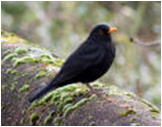|

|
Blackbird
While male blackbirds live up to their name, confusingly, females are actually brown, often with spots and streaks on their breasts. You'll quite often spot these birds hopping along the ground with their long tails up in the air. In winter, migrant blackbirds from northern Europe join our resident birds.
|